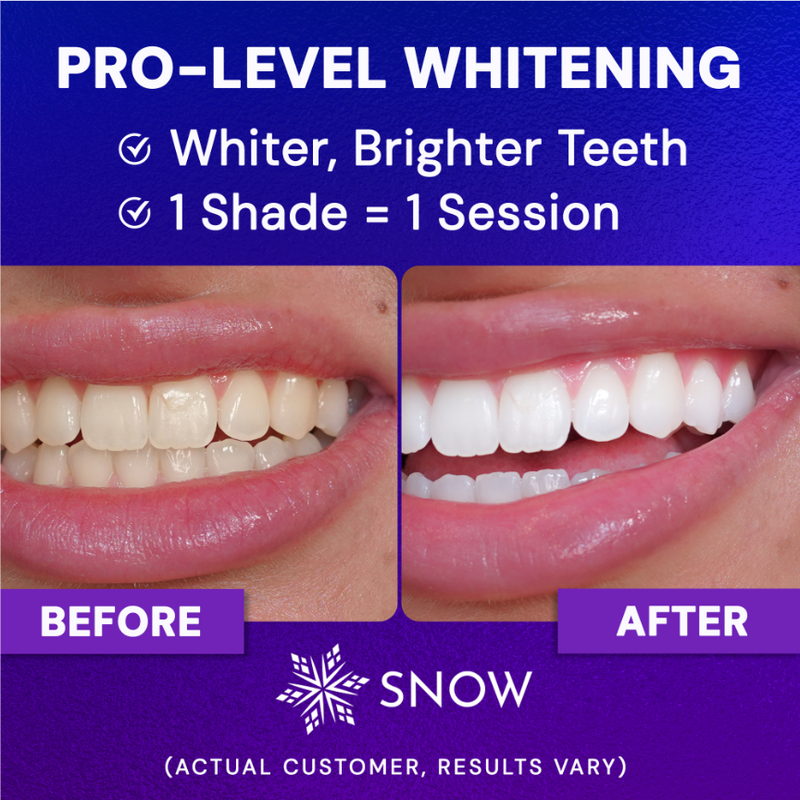Can a water flosser remove tartar? The short answer is no, water flossers cannot remove tartar once it has hardened, but they can play an important role in preventing its formation.
In this article, we'll reveal how water flossers help prevent tartar buildup, what tartar is and how it forms, and the best methods to avoid its development.
We'll also discuss when and how to use a water flosser, and the different types available to suit your needs. We're here to help you with your dental queries, from how to clean water flosser, how often should you water floss, and much more!
Ready to dive into the details and upgrade your oral care routine?
What this article covers:- Are Water Flossers Able to Remove Tartar?
- Does a Water Flosser Help Prevent the Formation of Tartar?
- What Is Tartar And How Does It Form?
- How to Prevent Tartar
- When to Use a Water Flosser
- What Types of Water Flossers Are Available?
- Signs of Tartar
Are Water Flossers Able to Remove Tartar?
When it comes to removing tartar, a hardened form of calcified plaque, water flossers fall short. Tartar cannot be removed by simply flushing it away with water.
Professional dental cleanings are required to fully remove tartar once it has formed.
Does a Water Flosser Help Prevent the Formation of Tartar?
Yes, a water flosser is effective in preventing tartar. Water flossers excel at reaching areas that might be difficult to clean with regular floss, like around braces, bridges, or implants.
This helps ensure a more thorough cleaning, essential for preventing tartar, especially for those with dental appliances or gum sensitivities.
Try SNOW Water Flosser for an easy, effective way to protect against tartar buildup. It offers three customizable modes—Pulse, Normal, and Soft—making it suitable for sensitive gums and varying cleaning needs.
Can I use water flosser everyday? You can and you should for optimal health.
For tighter gaps, consider SNOW's Activated Charcoal Whitening Floss. Made from natural bamboo fibers, it expands to clean between teeth and uses activated charcoal to detoxify and remove surface stains, keeping your teeth plaque-free.
What Is Tartar and How Does It Form?
Tartar, also known as calculus, is a hardened deposit that forms when plaque—an invisible, sticky film of bacteria—remains on the teeth for too long.
Plaque is constantly forming from food particles, bacteria, and saliva. If not removed through daily brushing and flossing, it can calcify and turn into tartar, which bonds to the teeth and is much harder to remove.
Tartar is not only unsightly, but it also provides a surface for more plaque to build up, which can lead to serious oral health issues like gum disease and tooth decay.
How to Prevent Tartar
Preventing tartar buildup starts with a consistent oral hygiene routine. Our findings show that brushing your teeth twice a day with fluoride or nano-hydroxyapatite toothpaste and using an electric toothbrush are cornerstone habits.
Plaque can form in as little as four to twelve hours after brushing, so staying diligent is essential. Flossing daily is also crucial for removing food particles and plaque between teeth where a toothbrush can't reach.
Using a mouthwash can provide extra protection. Incorporating a water flosser into your routine can further support plaque removal.
For a complete oral care routine, use SNOW's Charcoal Whitening Floss Picks. These picks combine activated charcoal to remove stains and plaque with sturdy minty picks, perfect for on-the-go flossing.
When to Use a Water Flosser
Water flossers should be used before brushing, preferably in the evening, to prevent bacteria from accumulating during the night.
For an extra boost of freshness and whitening, try SNOW's Arctic Frost teeth whitening mouthwash, which not only freshens breath but also whitens teeth while fighting plaque.
What Types of Water Flossers Are Available?
Water flossers come in two main types: countertop and cordless. Each has its benefits depending on your needs.

Countertop Water Flossers
Countertop water flossers come with large reservoirs that allow for longer cleaning sessions—up to 90 seconds of continuous use.
Countertop models are also ideal for family use, as many come with multiple tips for individual users.
Cordless Water Flossers
Based on our observations, cordless water flossers are compact, lightweight, and perfect for travel.
These models are great for convenience and portability.
Signs of Tartar
One of the first signs is a rough or crusty texture on the teeth. Tartar can also be yellow or brown in appearance as it traps stains and discolors the teeth.
Other common signs include bad breath, bleeding gums, and gum inflammation, which can progress into more severe gum disease if untreated.
Conclusion
Tartar buildup is a common issue, and while water flossers cannot remove it, they are essential for preventing it from forming. It's a powerful tool for keeping your teeth and gums clean and healthy.
Throughout this article, we've discussed how water flossers contribute to plaque prevention, how tartar forms, and the best ways to prevent it.
We've also explored the types of water flossers available and when to use them to maximize your oral hygiene routine.
If you're ready, check out SNOW's water flosser and whitening products. Take the next step toward a healthier smile today!
If you want to learn more, why not check out these articles below:
- Can You Put Mouthwash in a Water Flosser
- How to Get White Teeth in 1 Day with Toothpaste
- Is It Safe to Use Whitening Toothpaste Everyday
- Should You Leave Toothpaste on Your Teeth
- Best Toothpaste for Thyroid Patients
- Best Toothpaste for Smokers and Coffee Drinkers
- Best Water Flosser
- Best Dental Floss
- Best Portable Water Flosser
- Best Travel Water Flosser
- When Is the Best Time to Floss
- Dental Tape vs Floss
- Dental Pick vs Floss
- Air Floss vs Water Floss
- Do Water Flossers Work?






































































